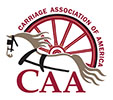Among the speakers at the annual banquets of the Carriage Builders’ National Association, which have been held regularly for the past forty-two years, there have been many men of national prominence.
On one occasion, in Boston, Rev. Edward Everett Hale was the principle speaker; Peter Cooper, the philanthropist, addressed the Association in New York; our martyred President, William McKinley, while Governor of Ohio, spoke to the carriage builders at Columbus. Oliver Wendell Holmes, author of the famous “One Hoss Shay,” was an honorary member and poet laureate of the Carriage Builders’ National Association.
But it was in 1884, in St. Louis, that General William Tecumseh Sherman, then a resident of the Missouri city, made a speech before the Association that is well remembered by those who heard it, “even unto this day.”

The General was introduced by Henry C. McLear, formerly mayor of Wilmington, Del., who was at that time president of the carriage men’s organization, as “one who shall be remembered as long as our glorious flag shall wave.”
General Sherman’s experiences with horses, carriages and wagons were given in the following sentences, which contain a prophesy as to the future of horse-drawn vehicles, which the General believed would be used “till the end of time”:
“You are workers in one branch of the mechanical art, but there were those who were working in this line before you were born. There wee people here in St. Louis forty years ago who made wagons, and I do not believe them better, and yo may make them a little lighter. It may be that you make them stronger. But a better wagon with which to cross the plains, as I once crossed them, without breaking a bolt, cannot be made in the city of St. Louis, I think, than the wagon of old times.”
“I often see beautiful carriages and wagons, and am tempted very much indeed to buy them. I have about half a dozen now, which is more that I can stagger under. But I always look back with particular pleasure to that old wagon in which I drove over the plains to Portland, Oregon, many years ago. After I arrived there I examined it, from the kingbolt to the boot, and found it sound as a dollar, and the quartermaster receipted for it without hesitation.”
“Now, gentlemen, the quantity of wagons manufactured is becoming something enormous, and the consumption of wagons in this country is almost beyond computation. The number is such that you, who manufacture them and employ workmen to manufacture them, will find occupation in that business to the end of time. You all remember – though perhaps not all of you, because I see some young faces here – but some of the gentlemen whom I see here remember the fact that the old Pennsylvania farmers actually arose in rebellion when the public was going to build a railroad to take the place of the stage line, because they could no longer sell their oats to the horses that drew the stages. I remember myself to have seen almost a riot in the State of Pennsylvania in those days. The farmers said they could not sell their oats to a locomotive, because a locomotive could not eat oats. But, after a while, they found out their mistake. So it will be with you to the end of time. You will always have plenty of work to do, and the lighter and stronger and more honest you make your work, the better you will be compensated for it. “
“I have seen some strange wagons in my day. I remember the wagons in general use in California. When I first went there, in 1847, there was no such thing as a modern wagon on that coast, excepting the cart we brought out in the ship ‘Lexington.’ All the other vehicles there had wooden axles, and were drawn by three or four yoke of cattle. You could draw about eight hundred pounds of hides upon each one, and you could hear the creak of its axles three miles off. If you want to see such a vehicle as that, you can, by going to the Smithsonian Institute in Washington. They use vehicles now in Tiflis, Russia, where you may sit upon the seat behind the driver, along with your baggage; and with such vehicles they transport passengers a distance of several thousand miles. I think their bones must be very hard, for I believe I could not stand it for more than thirty miles”
“I will prophesy what will be the probable end of this thing. We shall have to supply those foreign parts, and we are already exporting American buggies and American carriages to may parts of Russia and Asia, because they consider in Russia that the American wagons are superior to the English, French or German. In California they make a kind of wagon which I do not see often in this country. I possess one. It is called a ‘mountain wagon.’ It is made with good, thoroughbrace leather springs, and is very strong and light. These are made for the purpose of crossing the Sierra Navadas and the Rockies, and some people insist that they even climb trees.”
From Carriage and Wagon Builder and American Vehicle (Combined) February 1915, Vol XXVIII, Number 2. Page 13

